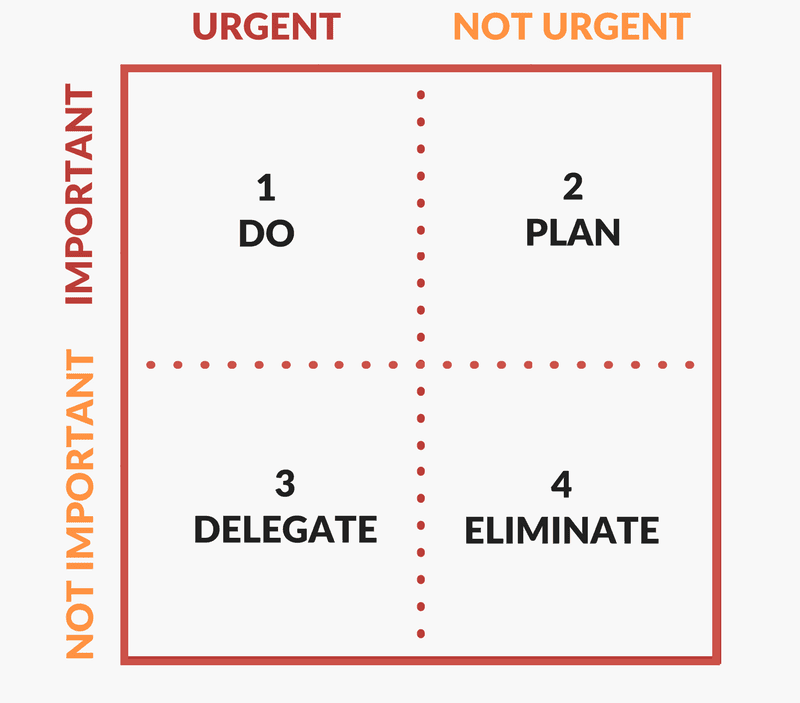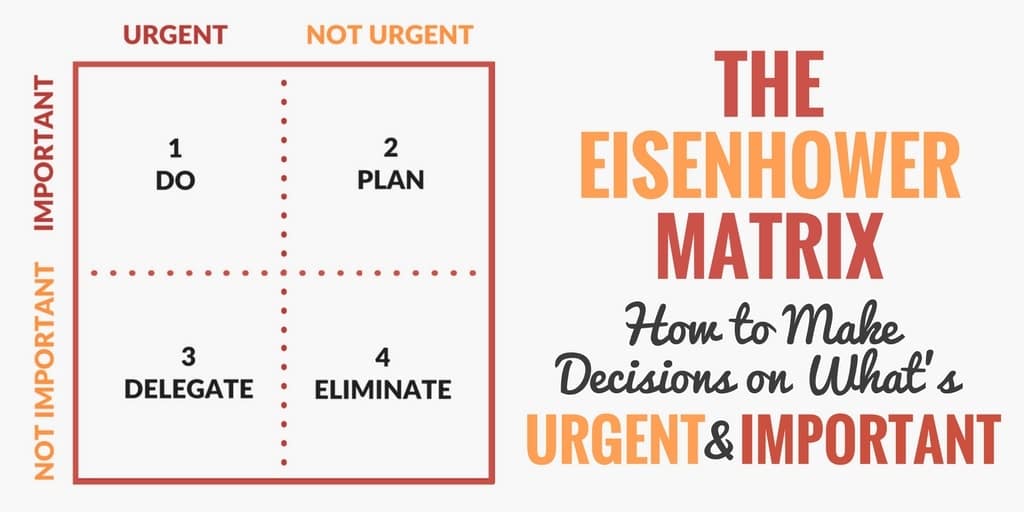There might be affiliate links on this page, which means we get a small commission of anything you buy. As an Amazon Associate we earn from qualifying purchases. Please do your own research before making any online purchase.
Picture this: You have a long list of things to do, and you have no idea where to start.
If you're anything like me, you want to get everything done at the same time so it is all behind you and you can move on.
But how can you decide what needs to be done first, and what can wait?
The Eisenhower Matrix, which is also known as the Urgent-Important Matrix, helps you prioritize your tasks based upon their urgency and importance. It also allows you to identify tasks that you should either delegate or leave undone.
How President Eisenhower Used This Matrix

Prior to becoming the 34th President of the US, Dwight Eisenhower served as a general in the army, and as the Allied Forces Supreme Commander during World War II. During his time in the army, Eisenhower was faced with many tough decisions concerning the tasks he had to focus on every day. This led him to invent a principle that helps us prioritize our tasks by urgency and importance.
Using the Eisenhower Matrix
This Eisenhower matrix results in four quadrants with various strategies. Stephen Covey, the author of The Seven Habits of Highly Effective People, further popularized Eisenhower's concept of this time management matrix by supporting Eisenhower's use of four quadrants to determine the urgency of one's tasks.
Here is how the four quadrants work:

Quadrant 1: Do First
Quadrant 1 contains tasks that are both urgent and important. These are “do first” tasks because they are critical for your life or career in some way and need to be finished right away. You want to get these tasks done as soon as possible.
These are the tasks that need to be done in order to avoid negative consequences. It is important to be able to manage the tasks that are in quadrant 1.
An example of a quadrant 1 task in your career may be answering a time-sensitive email from a client. This matrix can also be used in your personal life. An example of a quadrant 1 task in your personal life may be a crying baby, a medical emergency, or something burning in the oven.
Quadrant 2: Decide When
The tasks in quadrant 2 are important, but not urgent. This is where you want to invest the majority of your time. Quadrant 2 tasks are in line with your long-term goals.
What are some examples of these tasks? Well, exercising is important to your health, but you can decide when that can be done. It is also important to spend time with your family, but again, that can be aligned with your schedule. When it comes to your career, it may benefit you to obtain another degree or get a certificate of some sort. These things are important to your career, but they do not need to be done immediately.
It is important to remember here that everyone has different goals and objectives, so just because something falls into quadrant 2 for you, it may not for the next person. Also, just because these tasks are not urgent does not mean that they are not important. People often associate urgent matters with being important, which is not always true. Because your goals will stay constant, anything that will be beneficial to you in the long term will fall into the second quadrant.
Quadrant 3: Delegate It
Do you ever feel that you put too much importance on a task that in hindsight was not very important? Or think something has to be done right away, and it actually doesn't?
If so, you are in good company.
This common mistake often occurs when someone asks you to do something that does not directly benefit you or get you closer to achieving your goals. For quadrant 3 tasks, it is important to learn and remember how to delegate certain things.
When you think something is urgent but it actually is not, it is usually an outside source of distraction. This may include constantly checking your email or phone, or responding to people as soon as they try to contact you. You may think it is urgent at the moment, so you stop what you are doing to tend to the matter. But in reality, it could wait.
If you are in the middle of working on a project and the phone rings, it is not important for you to answer it. So, you can delegate this task to someone else. It may seem urgent at the time while it is happening, but these little things can be handled by other people.
Quadrant 4: Delete It
Honestly, you want to avoid quadrant 4 tasks. These tasks are simply a waste of your time, and they should be eliminated. If you are able to identify and eliminate all of your quadrant 4 tasks, you will free up some much-needed time to invest in your quadrant 2 tasks.
Some examples of quadrant 4 tasks are playing video games, watching television shows that you have already seen, or mindless web browsing.
Does that mean nothing in quadrant 4 should be a part of your life? No. Having a balance between your professional and personal life is important, and downtime helps you regain your energy. The challenge here is to spend most of your time in quadrant 2, and just enough time in quadrant 4 to get by.
Procrastination and the Eisenhower Matrix
Sometimes it is easy to mistake the differences between your tasks. Maybe you have a list of things you have to do that seem equally urgent and important, but can’t seem to get them all done. Part of procrastination is figuring out why you are procrastinating. Without doing this and addressing the matter, you are likely to spend a lot of time on quadrant 3 and quadrant 4 tasks that don't really matter.
It is easy to procrastinate on quadrant 2 tasks because, while they are important, they do not need to be done right away. If something more urgent comes your way, like a phone call or even just a favor for a co-worker, these are likely to take precedence in your mind, but end up being just another form of procrastination.
How to Use the Eisenhower Matrix to See If You Are Procrastinating
To see if you are spending the bulk of your time in the first two quadrants, do a one-week assessment. To do this, make six copies of a blank grid, and use one grid per day, listing the tasks you accomplished or the activities you did, and the time spent on each thing. When all of the grids are full, combine the Monday-Friday data onto your sixth summary grid and calculate how much time you spent in each grid, then break those numbers down into percentages. Evaluate how effectively you spent your time and whether your process needs to be reorganized.
(To learn about other decision matrices, check out these free decision matrix templates!)
Brain Dump
Why is this important?
We live in a time-pressured world where you are likely to have multiple overlapping commitments that feel like they need to be done right away. This means that true urgency is not reserved for special instances, because urgent matters seem to be an everyday occurrence.
You will not succeed in your career if you are constantly missing deadlines or letting truly urgent matters just sit on your desk. Instead, you have to learn how to manage your constant reception of responsibilities while still doing excellent work. The Eisenhower Matrix is an effective method to use to organize your priorities.
As previously mentioned, this spills over into your personal life as well. For example, you may get a personal phone call at work that seems urgent but in reality, is really not very important. That needs to fall into the appropriate quadrant in order for this strategy to be effective.
If you see something that is urgent and important, and that will have a large impact on your future, set aside an entire half-day to focus on it. Get rid of any possible distractions, turn off your email and phone, close your door, or even take the project to a remote office area where no one can distract you. Complete the task so you can cross it off your list.
It is easy to spend the bulk of your time in quadrants 1 and 3, and very little time in quadrant 2. Quadrant 3 is popular because it makes you look and feel busy. However, in order to be productive and effective in the long-term, quadrant 2 should be where you put your main focus.
You can also look at the matrix like this: Live most of your life in the upper part of the matrix. Work on quadrant 1 to get by and use the rest of your time in quadrant 2. Use quadrants 3 and 4 only when necessary.
Eisenhower.me
So this all sounds like a great idea in theory, but where do you get started? Eisenhower.me is a website that is created with simplicity in mind to make the process easy for you. They are able to let you know where your tasks fall in the quadrant grid through apps and strategies. This will then help you focus and work on the most important tasks. Eisenhower.me helps you prioritize and plan your schedule easily while minimizing any stress and increasing your productivity.
You may be thinking that this tool sounds old-fashioned since it is associated with Dwight Eisenhower. It is an old idea, but it is widely accepted and has been used successfully for decades.
Following the guidelines presented on Eisenhower.me will benefit you by saving you time. Time cannot be purchased and is often mismanaged by people. This tool gives you the opportunity to think about the time that you unconsciously waste every day.
When you apply these practices to your professional and personal life, you are able to plan ahead, increase your effectiveness, and boost your efficiency. You want to be able to manage your work with your available time to avoid procrastinating, which will then help decrease stress. Improper time management can easily lead to stress and job burnout.
Learning the principles of planning, prioritizing, delegating, and scheduling will help you see the right things to do in order to be successful. This is a simple matrix to help you achieve your goals and be successful in life.
==>>Check out the Eisenhower.me website
Finally, if you want to level up your productivity and time management skills, then watch this free video about the 9 productivity habits you can build at work.



Very informative article. The Eisenhower Matrix is a definitely great way to organise your workload in order to maximise efficiency.
That’s why we created our new app, eisedo. It’s actually based on the Matrix itself.
What makes it different compared to other apps, like Eisenhower.me, is the fact that it automatically prioritises your tasks for you. We take the hard work out of manually arranging your tasks into the quadrants, so you can focus on working productively.
Good luck with your app Zerin. Sounds like a solid concept.